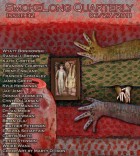The brevity of “Twining” is achingly apt. Can you share with us your process and how you arrived at this wonderful story? My sense is this story was formed from multiple, longer drafts that, like a sculpture, you pared down until you brought out the heart of the piece and nothing more.
My story was inspired by the death of a longtime friend who passed away this year in France. His death was gradual and painful for his friends and family to watch, and my sadness was exacerbated by the fact that I wasn’t there to say goodbye. I wrestled with the idea that someone can die one day, and then the next day it’s back to work. The challenge becomes hanging onto their memory in a world that is always moving too fast. I wanted to write something that would engrave his memory, and I chose to do it through the point of view of my oldest and dearest friend, who also lives in France, and who had cared for him during his decline.
The brevity is directly due to my coursework in the MFA program at the University of San Francisco. Between intense compression exercises in Lewis Buzbee’s long fiction workshop, which are an excellent way to discover the poetry in any story, and the study of stylists as varied as Faulkner and Amy Hempel in Nina Schuyler’s style class, I ended the spring semester with a greater awareness of my own style. I am a very slow writer and need to be satisfied with each sentence before I can move on to the next. While this process can be detrimental to productivity, especially when assignments are due, lingering in each sentence allows me to uncover the rhythm and meaning of my prose. I think this, in turn, creates sentences that work harder by saying more with fewer words.
There’s also such astute and precise attention to place in “Twining,” so much so the garden feels full of movement and fully alive, essentially another character in the story. How important is place and personification in your work as a whole?
I tend toward magical realism and surrealism, so it’s crucial that the world of the story be believable enough to allow me to take unexpected turns in the narrative without losing the reader. I always want the actions of my characters to be understandable, even if the reader doesn’t identify with them, and that requires grounding their actions in a world that is filled with recognizable ordinary details. In the case of “Twining,” that also meant I had to not be afraid to write about the slow life of a garden or the cliché of rebirth in spring, which I found to be very challenging.
The language, imagery and emotion of “Twining” are both lovely and haunting, can you talk a little about the juxtaposition of the beauty and the grief here?
My parents are lifelong gardeners, and I grew up surrounded by a gorgeous backyard that was always fully alive, even in winter. The love of gardening is still a part of my life today, even though I live in San Francisco and have a blip of a backyard. My friend in France is also a dedicated gardener with a beautiful yard, so it was easy to get into the frame of mind that recognizes how therapeutic gardening can be.
But I also wanted to allow my character to go to a place of grief without her being perceived as overwhelmed, depressed, or crazy. That’s why I finally settled on the phrase “You imagine.” It was important to me that her fantasy be seen as therapeutic and positive, as a way of honoring not only what his death means to the character’s life, but to all of our lives, and I think that’s what makes the juxtaposition effective.
Can you share some thoughts on your craft choices, I’m thinking in particular about your use of the second person, the inclusion of the walking cane, and how you arrived at that last gorgeous image and line?
I decided on the second person for many of the same reasons that make the use of second person so intimidating. Its experimental nature supports the story’s narrative, it pulls you more intimately into the story, and it creates a sense of detachment, which I think prevents the story from becoming melodramatic.
For me, the walking cane is the crucial image in the story. To immediately see something so ordinary and inanimate rooted and sprouting tiny leaves indicates that this isn’t just any garden. It also creates the possibility that the cane might be a memorial to someone else. In either instance, the cane foreshadows the fantasy for the character as well as the reader.
The final image itself was inspired by a sculpture in Chicago known as Magdalene, but the phrase “tiny snails seeking shelter” comes directly from a conversation I had long ago with my friend about gardens. If you do any gardening at all, you know that they can be tricky little buggers. They are ever-present, yet they can be so difficult to find. But when I imagined them crawling on my skin, all I could do was laugh, and I loved the irony in that. The slimiest, most reviled creature in the garden becomes the one creature that can make you laugh your way out of your grief.
How representative is “Twining” of your work as a whole? Do you normally write such tiny gems or do you also write longer works? If the latter, can you share the ‘how and why’ you arrive at stories and works of varying lengths and range?
So far, I have primarily been a short story writer, but I’m also writing my first novella, and I do hope to write a novel someday. I started writing flash fiction because of the creative writing exercises assigned in the program, and now I am in love with the shorter form. It is the perfect way to keep writing if you are stalled on a longer piece, it is great practice for exercising your compression skills, and it is often the best and only way to tell a particular story or to communicate the power of a particular image.
I come from many years of laboring in the screenwriting world, so I am extremely image-driven, sometimes to a fault. Most of my stories are inspired by a specific image, almost always a photograph of something unexpected and intriguing, something I can’t stop thinking about. From there, I surrender to the most exhilarating aspect of being a writer: the leap of faith. I don’t plot the story in advance, which is the complete opposite of how I approach my screenwriting. I just let my imagination go. I think I have an innate sense of storytelling after all these years of writing and teaching, and that helps to remind me of the time-worn strategies for structuring stories. But my conscious mind prefers to think that my unbridled imagination is what fuels my storytelling. Who wants to argue with that?
What’s next for your writing?
Finishing my collection of stories!



 The core workshop of SmokeLong Fitness is all in writing, so you can take part from anywhere at anytime. We are excited about creating a supportive, consistent and structured environment for flash writers to work on their craft in a community. We are thrilled and proud to say that our workshop participants have won, placed, or been listed in every major flash competition. Community works.
The core workshop of SmokeLong Fitness is all in writing, so you can take part from anywhere at anytime. We are excited about creating a supportive, consistent and structured environment for flash writers to work on their craft in a community. We are thrilled and proud to say that our workshop participants have won, placed, or been listed in every major flash competition. Community works.